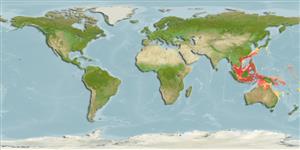Environment: milieu / climate zone / depth range / distribution range
Ecologia
marino demersale. Tropical
Western Pacific: Hainan, China to Thailand and Indonesia.
Size / Peso / Age
Maturity: Lm ? range ? - ? cm
Max length : 18.0 cm TL maschio/sesso non determinato; (Ref. 42740)
Spine dorsali (totale) : 4 - 5; Raggi dorsali molli (totale) : 20 - 24; Spine anali: 1; Raggi anali molli: 16 - 20. Upper half of body with 7 dusky bars containing 3 or 4 dark brown dots in their lower part, the last 6 as 3 pairs. Below each pair, on lower side, a large dusky blotch. 2 small dark brown spots, one above the other, at base of caudal fin. Anterior rays of soft portion of dorsal fin prolonged and filamentous in large adults), the second to fourth longest, 1.7 to 3.8 in standard length (over the range of 6.7 to 11.4 cm standard length)
Possibly on mud bottoms (Ref. 42740).
Life cycle and mating behavior
Maturità | Riproduzione | Deposizione | Uova | Fecundity | Larve
Randall, J.E., 2001. Pinguipedidae (= Parapercidae, Mugiloididae). Sandperches. p. 3501-3510. In K.E. Carpenter and V. Niem (eds.) FAO species identification guide for fishery purposes. The living marine resources of the Western Central Pacific. Vol. 6. Bony fishes part 4 (Labridae to Latimeriidae), estuarine crocodiles. FAO, Rome. (Ref. 42740)
IUCN Red List Status (Ref. 130435: Version 2024-1)
Threat to humans
Harmless
Human uses
Pesca: di nessun interesse
Strumenti
Special reports
Download XML
Fonti Internet
Estimates based on models
Preferred temperature (Ref.
123201): 15.2 - 27.9, mean 23.7 °C (based on 412 cells).
Phylogenetic diversity index (Ref.
82804): PD
50 = 0.5000 [Uniqueness, from 0.5 = low to 2.0 = high].
Bayesian length-weight: a=0.00692 (0.00314 - 0.01524), b=3.06 (2.88 - 3.24), in cm total length, based on LWR estimates for this Genus-body shape (Ref.
93245).
Trophic level (Ref.
69278): 3.5 ±0.4 se; based on size and trophs of closest relatives
Resilienza (Ref.
120179): Alto, tempo minimo di raddoppiamento della popolazione meno di 15 mesi (Preliminary K or Fecundity.).
Fishing Vulnerability (Ref.
59153): Low vulnerability (10 of 100).
